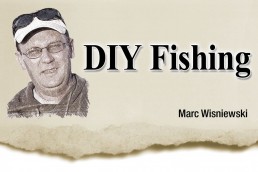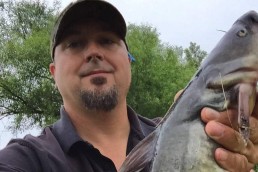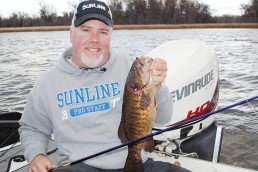The Weighted Hook: A Versatile Option for Soft Plastics
SHARE THIS POST
Swimbaits have been around for decades now if you consider the original Mister Twister Sassy Shad. In recent years, the term “swimbait” has led to seeing many shapes and styles of plastic-bodied baits. Most notable is the hollow-body- or split-belly-style swimbait that took the bass world by storm 15 years ago. The system became so popular that a special hook design was needed to make this bait weedless, and more versatile. The answer was a variety of weighted hook systems that would offer the ballast in the belly of the hollow-body swimbait and feature a big enough gap to span through the body of a bait and protrude slightly out the back of the plastic.
Thus is the origin of the “weighted hook.”
With so many different swimbaits, finding the right hook for each size and style became difficult. Some made the baits run nose-down and some made them ride nose-up. It’s a very simple bait, but the “balance” of it is very tricky. I was buying many different styles and shapes to get the right action out of a particular bait. And at about $1.50 per hook, this started to add up. Thankfully, I discovered the Do-it Molds Weighted Hook Jig.
Do-it produces three different molds in these to cast hooks weighing 1/16 all the way up to 7/16 ounce. Their SMB-4S-EWG mold casts weight on a typical extra-wide gap hook many anglers were accustomed to at the inception of this system. With this hook, though, the bait gets rigged very similar to Texas Rigging a soft plastic worm.
My personal favorite is their SMB-4-MTD—and the SMS-3L-MTD for big hooks—that uses a wide-gap Mustad 91768BLN hook and their curly wired Hitching Post in the nose of the bait. Over the years I’ve found this rigging system is a little easier on the nose of the plastics and seems to offer a higher-percentage hook-set.
The beauty of making your own weighted hooks is not only the money saved, but now you can also make the exact size and weight for any style of hollow-body swimbait on the market. And, every one has that sweet spot where you want the weight, at just the right amount.
There are weights of 1/16, 1/8, 3/16 and 1/4 ounce for the SMB-4-MTD with hooks ranging from 3/0 to 5/0. Its larger counterpart, the SMB-3L-MTD, casts weights of 5/16, 3/8 and 7/16 ounce on hooks from 6/0 to 8/0. Between these two molds, there is virtually no swimbait that can’t be rigged properly.
This is where you can really dial in the weight and position that you want. There is ample flexibility within the cavities of this mold so you can move the hook around until you get the weight where you want it on a hook. You can also grab the weight with a pliers right after you mold it and slide it gently in either direction. If you want just a hair less weight, clip a little lead off either end with a side-cutter.
The Hitching Post is a coiled piece of wire with a clip bent on one end; this gets added to the eye of the hook. The Hitching Post is then screwed into the nose of the plastic and then the hook gets inserted into the bait.
Some leave the point of the hook buried in the plastic. It’s a weedless system, but it’s also harder to set the hook. I prefer to have the hook come through the plastic and lay just above the surface of the bait. This seems to be the best of both worlds. If it’s lying tight enough to the plastic, it’s still virtually 100 percent weedless. But if you want to be sure, just tuck the very point of the hook back into the plastic, known as the ‘Texposed” hook.
Are you enjoying this post?
You can be among the first to get the latest info on where to go, what to use and how to use it!
The Weighted Hook was designed for swimbaits, but it can be used for much more. I literally almost never Texas-rig anything anymore since I discovered Do-it’s Weighted Hooks. First of all, let me tell you that the mold says that it accepts hooks “from 3/0 to 5/0,” but I get hooks down to 1/0 in the smaller weights, so almost any size of the plastics are good. For starters, these work great on fluke-type soft plastic jerkbaits. Here, again, you can fine-tune the weight to give you the action you desire: a nose-down fall, upward dart or a flat, horizontal slow-sink.
For things that crawl on the bottom, these are superb. Straight worms, ribbon worms, and even Senko-type stick worms, are completely “weedless” with no bullet weight to tangle in weed stems or brush. And lizards of all sizes are perfect for the weighted hook, as are creature-type baits and other crawfish imitations. Even tubes can be fished on these for a different look and for swimming or bottom-dragging.
Painting weighted-hook jigs is optional. I like to just paint all of mine black, but they can be colored to match swimbaits or just left with the bare lead.
Do-it’s Weighted Hook Jig mold is more than just a great swimbait hook. With many hook sizes, it’s ready for anything from smallmouths to mighty muskies. If you fish around and through weeds, this mold will be your soft plastic’s new best friend. And on top of that, there is nothing better than catching a fish on a lure you made yourself.
Worms, lizards, flukes, creatures and even tubes. Weighted Hook Jigs are great for fishing weeds snag-free.
The Do-it Weighted Hook Jig and Hitching Post is perfect for weedless rigging of a variety of soft plastic lures.
The Weighted Hook was developed for hollow-body swimbaits.
Hook points should lay flat along the back of the plastic or rig ‘Texposed,’ with the point inserted back in the plastic.
MWO
SHARE THIS POST
Did you enjoy this post?
You can be among the first to get the latest info on where to go, what to use and how to use it!
Marc Wisniewski
Marc Wisniewski is an avid Wisconsin angler specializing in Lake Michigan shore and inshore fishing. He also chases bass, pike, and muskies anywhere he can. He has built custom rods for 35 years and makes lures from wood, lead and soft plastics. Wisniewski has been writing fishing articles for more than 30 years.


